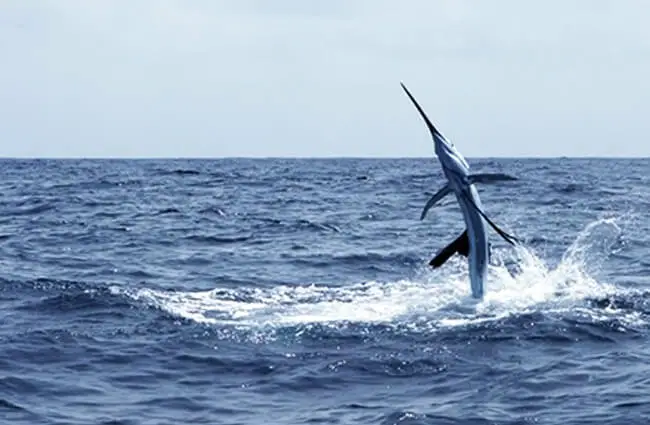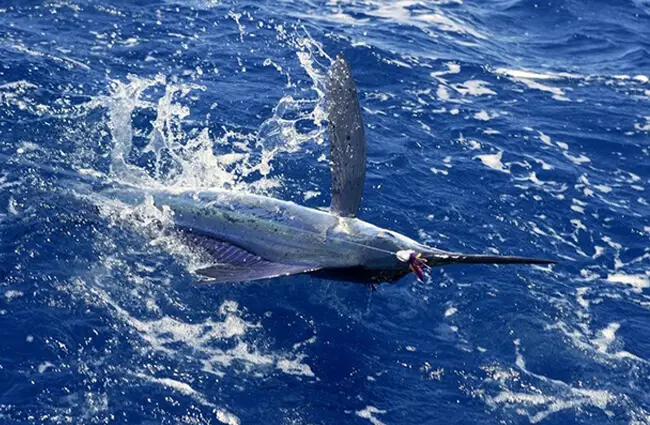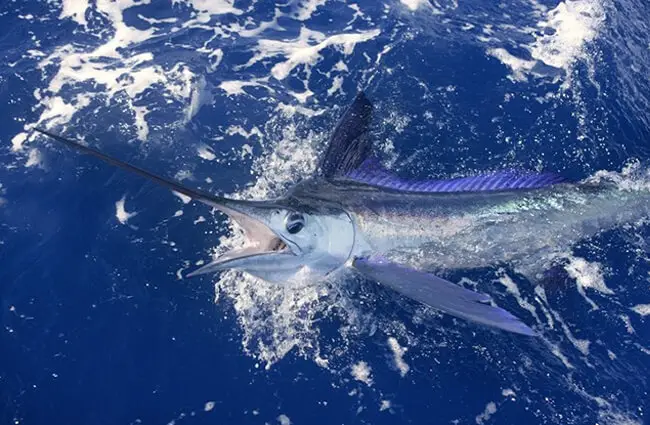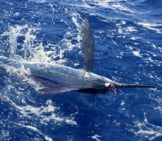The White Marlin is a species of fish in the Istiophoridae family. Other members of the family include other marlin species, such as blue marlin and black marlin, as well as sailfish, and spearfish. The closest relative of this species is the striped marlin, which shares the taxonomic genus Kajikia. Read on to learn about the White Marlin.
Description of the White Marlin
As the name suggests, parts of this species have bright iridescent white-silver coloration. Along the back of the fish, the scales have dark blue coloration. Like all marlins, this species has a long, pointed bill.
At their largest, this fish reaches lengths up to 9 ft. and weigh up to 180 lbs. However, most individuals do not measure nearly that size, and 5 – 6 ft. long is a more typical length.
Interesting Facts About the White Marlin
These fish have a number of interesting traits and adaptations. Learn what makes them unique, below.
- Countershading – When you’re hunting, it helps if your prey can’t see you coming. This fish has dark colored scales on its back and light-colored scales on its underbelly. This color scheme is known as “countershading.”
- Hiding in Plain Sight – Countershading helps the fish hide even when there’s nothing to camouflage with. When viewed from above they blend in with the dark colored sea. When viewed from below the light scales blend with the sunlight.
- Sportfishing – People often target this, and other marlin species, in the sportfishing industry. In addition to recreational capture, commercial fisheries also target this species as a food source. Unfortunately, this fishing pressure has resulted in population decline.
- Catch and Release – In an attempt to reduce population decline, many regions have implemented minimum catch sizes. Unfortunately, the process of capture and release greatly decreases the fish’s likelihood of survival as it expends large amounts of energy.
Habitat of the White Marlin
This species of fish has a pelagic lifestyle, which means that it swims in open water. It does not typically associate with coastlines or the ocean floor with any consistency. Though they range in depth, you can usually find these fish in warmer waters within 150 ft. of the surface.
Distribution of the White Marlin
The range of this species extends throughout most of the Atlantic Ocean from Europe and North America to South Africa and South America. It lives in tropical, subtropical, and temperate regions. Its range also extends into the Gulf of Mexico, Caribbean Sea, and Mediterranean Sea.
Diet of the White Marlin
Like other members of the family, this species has carnivorous feeding habits. Because it feeds primarily on fish and other sea creatures, researchers classify it as a piscivore. It most commonly hunts for small schooling fish and squid.
Its hunting methods reflect similarly to the rest of the family as well. It swipes its long bill swiftly back and forth after dashing into a school of fish. Then, it snatches up any fish stunned or killed by the swinging of its bill.
White Marlin and Human Interaction
Humans fish for this species both recreationally and commercially. Sport fishermen target these creatures for their unique bill and athletic prowess during capture. Commercial fisheries target the fish as a source of food. In many instances, commercial fisheries targeting other species catch this fish on accident as bycatch.
The IUCN lists the species as Vulnerable due to this activity and the resulting population decline.
Domestication
Humans have not domesticated this fish in any way.
Does the White Marlin Make a Good Pet
No, these fish do not make good pets. They reach sizes much too large to keep in a home aquarium, and their pelagic lifestyle makes it difficult to meet their needs.
White Marlin Care
People do not keep this fish in aquariums. Because they live pelagic lifestyles, they swim exceedingly long distances through open water. This makes it difficult to house them, even in incredibly large tanks designed for pelagic species, because they can damage their bills on the sides of the glass.
Behavior of the White Marlin
This species migrates seasonally. It moves away from the equator into cooler waters during the spring and summer. During the colder months it migrates back towards the equator and warmer waters. During its time in warmer waters near the equator it spawns, usually in pairs.
Reproduction of the White Marlin
These fish reproduce via spawning, where the female releases her eggs and the male fertilizes them outside of the body. A single female can produce several hundreds of thousands of eggs. After hatching, the young develop quickly, and reach maturity at about five feet long and three years of age.











![Red Angus Closeup of a beautiful Red Angus cowPhoto by: U.S. Department of Agriculture [pubic domain]https://creativecommons.org/licenses/by/2.0/](https://animals.net/wp-content/uploads/2020/03/Red-Angus-4-238x178.jpg)












![Red Angus Closeup of a beautiful Red Angus cowPhoto by: U.S. Department of Agriculture [pubic domain]https://creativecommons.org/licenses/by/2.0/](https://animals.net/wp-content/uploads/2020/03/Red-Angus-4-100x75.jpg)

